Introduction
In late 1919, Greta had her first real job in a local barber shop. She was working as a tvålflicka (a soap girl). A soap girl had to lather men's faces before they were shaved. Greta was very proud about her first job and took her work very serious. Her salary was seven kronor a week.
 
The PUB, in the 1920s and in 2008
Due of the family's dire financial straits and her need to make more money than a barbershop job could provide, Greta decided to find a better job and soon filled out a an application for the PUB (Paul U. Bergström's department store) in Summer of 1920.
The Pub is located at Hötorget in Nordermalm/Stockholm (Sweden). It is a huge brown-and-white-stone building with ‘1916' carved on its peak and a clock above the entrance to tell customers and employers when they are late for work. Paul U. Bergström's store was Stockholm's finest and most fashionable, and still is.
Nowadays, PUB customers shop to the soothing strains of Mozart, and hats await buyers in the same place and on the same type of elegant antler racks on which they rested in 1920.
Sources: Barry Paris – Garbo (1994) and Karen Swenson - A life Apart (1997)
Contend
1. The Shop-Girl
2. The Hat-Model
3. The Fashion-Model
4. The 'PUB' films
5. Greta's first romantic relationship
6. Greta leaves the PUB
The Shop-Girl
How did Greta get the job?
At first Greta was running errands and unpacked hats in the millinery department but after a while Greta was transferred to woman's clothing department.
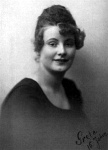
Greta before the PUB
She was the youngest of the ten sales girls. Magda Hellberg was the head of PUB's woman's clothing department. Greta was a shop girl now. Her starting salary was 125 kronor per month.
Garbo's sister Alva had two friends who were clerks at the Pub. With an entree from her Alva's friends, Greta was engaged there as a trainee on 26 July 1920, and hired soon after as a clerk in the fourth-floor millinery department at 125 kronor ($25) a month. Greta stated herself as 15 and spelled her name as “Gustavsson”. Soon after, Greta was given a job.

Alva, early 1920s
Miss “Gustavsson” was known as very ambitious, quiet and self-restraint. Greta slowly transformed into a mature person. She started to dress herself more lady-like. Her manner and speech changed too and she even lost some weight. Greta's family and friends treated her like an adult now. The 14 year old helped the family with her salary.
What did Greta say about her work?
Greta wrote a letter to her friend Eva Blomgren and talked about her new job and about selling hats:
“I have got a job at Paul Bergstrom's.... Can you imagine it, me a shopgirl! But don't worry; I haven't given up thought of the stage because of this. Not a bit; I'm just as keen as ever.”
“I was really interested in selling hats. It seemed like play. I never seemed to have to think how to treat the individual whims of each customer.... How I admired and envied the actresses among my customers!”
|
The Hat-Model
Greta and modelling hats
Bergström also arranged mail-order catalog sales. Paul U. Bergström was the owner of the department Store. One day, Hellberg was asked to suggest someone to model hats. Those were for the upcoming spring 1921 catalog.
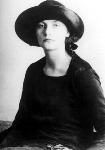
Greta models hats
She quickly named Miss "Gustavsson". Hellberg said that she would be perfect for that. She said that Greta always looks clean, well-groomed with a good face.
Greta accepted the new opportunity and said “Oh, how happy I am!”. Hellberg believed that this was the longest sentence she ever heard her say at one time.
  
The PUB's spring catalogue for 1921.
Greta was going to model for hats and soon she made photos. The Spring catalogue of 1921, showed Greta with several hats and poses.
|
The Fashion-Model
Greta on the ‘catwalk’
After the success of modelling for the Spring catalogue and Greta got another catalogue offer and the opportunity to earn extra money as a fashion model on the "catwalk" at PUB shows.
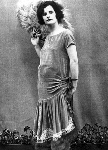 
Greta models, studio location
 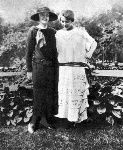
Greta models, outdoors location
Greta was photographed several times, some were made outdoors and some were made in a studio.
Pub's dramatic club theatre
Greta's co-workers said that she constantly talked about movies and theatre. They all knew that she wanted to be a professional actress. Although her stage interest was intense while working at the PUB, she was unwilling to do amateur theatricals – or perhaps just too shy and passive to explore the possibility.
Asked later why she never joined PUB's dramatic club, she replied, “That was not the real theater – it was play.”
|
The 'PUB' films
GG’s first films
The PUB was one of the best known department stores in Sweden. Even actors, directors, producers, writers and other film worker, visited the building in Norrmalm. While working at the PUB, Greta made three little advertising/promotional films and even starred in two feature films as an extra.
Greta in Herrskapet Stockholm ute på inkop
After her first modelling triumph, Greta met Captain Ragnar (Lasse) Ring. He was a writer/actor who was now directing short films and commercials. Those products were also shown in local movie houses as 'Advertising films'.
A short film was planned for the 40th Anniversary of the PUB. Lasse Ring would produce and direct. Many who worked for the PUB hoped to get assigned for “bit” parts. The production was titled Herrskapet Stockholm ute på inkop. Later known as Mr. and Mrs. Stockholm Go Shopping.
 
Från topp till tå or How Not to Dress
The director offered Greta 10 kronor a day for a small part in the production. In her first “role” she and other models had to wear outrageous outfits. This section is known as Från topp till tå or How Not to Dress.
The film was first screened in Stockholm theaters on December 12, 1920. This advertisement told the story of a family whose home had been burned. Now they were helped by the staff of Bergström's. Greta was assigned the role of the eldest daughter. She comes to PUB with her family to replace their lost wardrobe. They are re-dressed Från topp till tå (From Head to Toe). This was one of the store's mottos.
Greta in En Lyckoriddare
In late December, Greta took a week off from work. She and Alva had been promised work as extras in a motion picture. The film was En Lyckoriddare (A Fortune Hunter).

Still from the film
This historical drama premiered in March 1921 and is a lost film.
Greta in Konsumtionsföreningen Stockholm med omnejd
Director Lasse Ring asked Greta to appear in another promotional film. Ring would direct again. This short film was for the Consumer's Cooperative Association of Stockholm.
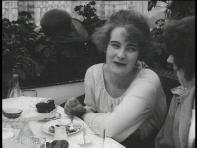 
Our daily Bread
The 27 minute short titled Konsumtionsföreningen Stockholm med omnejd. A small Promotional Film for Sweden's Baker Industry. It had Greta and a group of friends have tea on the rooftop terrace of the Strand Hôtel and later doing picnic in the park. Greta's part in the short film is known as Our daily Bread.
Greta in Karlekens Ögon
In early 1922, Greta and Alva worked again as extras in a film. The film was Karlekens Ögon (A Scarlet Angel).
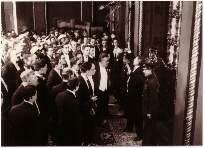
Still from the film
The movie drama premiered on October 1922 and is a lost film.
Greta in Sverige och svenska industrier
At an unknown time in 1922, a third Advertising or Promotional Film with Greta was made. It was called Sverige och svenska industrier.
 
Screencaps from the promo film
In this short film, Greta points at the town of Malmö on a wall map.
|
Greta's first romantic relationship
Max Gumpel
Greta had attracted an older admirer during the making of the short film Herrskapet Stockholm ute på inkop. His name was Max Gumpel, a bachelor in his early thirties and a wealthy construction baron. He was the owner and manager of one of Sweden's most successful construction firms.
He often visited the set. Gumpel's seven old nephew Erick, was also in the film. Erick played Greta's little brother. Years later Max said that he was very taken by Garbo. Greta liked his affable style and manner. One day he asked the 15 year old Greta to dine with him. She accepted and went to his glamorous apartment.

Gumpel, in later years
Greta discovered the social value of her position when Gumpel, showed up at her counter one day, was immediately attracted to her, and invited her home to dinner. Rather boldly, she accepted. Gumpel served artichokes to the dismayed girl, who had never seen such a complex vegetable before.
When they became better friends, he gave her a gold ring set with a small stone which she told him was ‘as beautiful as a diamond in the English Royal Crown'. Swedish discretion has erased any evidence, but Gumpel was very likely Garbo's first lover.
Greta's mother, Anna Gustafsson was pleased to see her with such a fine gentlemen. One day Max made her a present. A tiny gold ring with a small diamond in it. The dated for a while but one day in 1921, they separated. They were still good friends afterwards.
|
Greta leaves the PUB
No feature film with Lasse Ring
Greta worked at PUB for over a year now. Lasse Ring, who was working with Greta before on the PUB advertising films, asked her if she would like to be part in his next film. This was going to be real motion picture about a “Nordic Love story”. Sadly, the PUB's personnel department refused to let her go.
Greta's boss told Ring that he had to stop giving the girl crazy ideas about the movies and so she had to decline the offering and never made her motion picture with Lasse Ring.
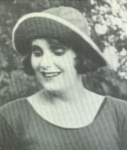
Greta in Luffar-Petter
Greta in an Luffar-Petter
A new man came into Greta's life, the producer/director Erik A. Petschler saw Greta in front of a shoe store. Greta captured the filmmaker's attention, Petschler was fascinated. He later saw her again, behind her counter at PUB. Greta heard about the film he was planning and hoped to get a part.
After a brief audition, Petschler offered her a part in his next film.
Greta hoped to get a release for the 2 weeks shoot. PUB declined and so Petschler asked the head of the PUB personally. He too had no success. Greta decided to leave the PUB after nearly 2 years.
On July 22, she had her last day in the department store and stated her reason for leaving as “To work on Film”. She was almost 16.
|
|